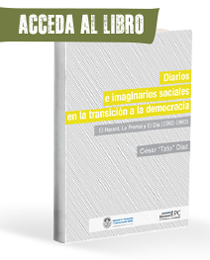Writing, Woman’s Bodies and Media. 8M in Argentina
DOI:
https://doi.org/10.24215/24690457e020Keywords:
writings, women, rhetorical order, journalismAbstract
The work reflects on antagonistic writings performed on the female body (violence and empowerment). For this, it focuses on the March 8, 2017 and the coverage made by newspapers and portals of Buenos Aires and Salta (Argentina). From there, two rhetorical figures, the oxymoron and the chiasmus, are identified. They refer to the order of culture, that is, to the matrices of meaning at the base of these social and discursive processes. The approach focuses on the studies of signs, languages and discourses in dialogue with the theories of journalism and gender studies based on anthropological and psychoanalytical.Downloads
References
ARRUETA, C. (2010). Calidad informativa en diarios regionales. Buenos Aires, Argentina: Educa.
ARUGUETE, N. (2015). El poder de la agenda. Política, medios y público. Buenos Aires, Argentina: Biblos.
AUSTIN, J. (1955). Cómo hacer cosas con palabras. Edición electrónica de www.philosophia.cl, Escuela de Filosofía, Universidad
ARCIS. Recuperado de http://revistaliterariakatharsis.org/Como_hacer_cosas_con_palabras.pdftaurus
BAJTÍN, M. [1975] (1989). Teoría y estética de la novela (trad. Helena Kriukova y Vicente Cazcarra). Madrid, España: Taurus.
BAJTÍN, M. [1982] (1990). Estética de la creación verbal (trad. Tatiana Bubnova). Ciudad de México, México: Siglo XXI.
BAREI, S. y MOLINA, P. (2008). Pensar la cultura 1. Perspectivas retóricas. Córdoba, Argentina: Grupo de Estudios de Retórica.
BRUNETTI, P. (1995). Factoides en la prensa diaria. ETC. Espacios de ficcionalidad, 2, 45-57.
BUTLER, J. (2016). El género en disputa. El feminismo y la subversión de la identidad. Barcelona, España: Paidós.
BUTLER, J. (2017). Cuerpos aliados y luchas políticas. Hacia una teoría performativa de la asamblea. Buenos Aires, Argentina: Paidós.
CEBRELLI, A. (2016). Periodismo de género. El caso de las violaciones en Salta «la linda» [Conferencia]. Salta, Argentina: I Forum de Periodismo.
CHARAUDEAU, P. (2003). El discurso de la información. La construcción del espejo social. Barcelona, España: Gedisa.
DERRIDA, J. (1971). De la gramatología. Ciudad de México, México: Siglo XXI.
FERNÁNDEZ PEDEMONTE, D. (2015). Nisman, el caso conmocionante. Buenos Aires, Argentina: Universidad Austral. Recuperado de http://hdl.handle.net/123456789/557
FORD, A. (1999). La marca de la bestia. Identificación, desigualdades e infoentretenimiento en la sociedad contemporánea. Buenos Aires, Argentina: Norma.
FOUCAULT, M. (2002). La arqueología del saber. Buenos Aires, Argentina: Siglo XXI
GIACOMETTI, M. (2017, 4 de marzo). Las argentinas van al primer paro internacional de mujeres en reclamo de sus derechos. Ámbito.com. Recuperado de http://www.ambito.com/874777-las-argentinas-van-al-primer-paro-internacional-de-mujeres-en-reclamo-de-sus-derechos
GRUPO μ (1987). Retórica general. Barcelona, España: Paidós.
KRISTEVA, J. (1991). Extranjeros para nosotros mismos. Barcelona, España: Plaza & Janés.
LACLAU, E. (1996). Emancipación y diferencia. Buenos Aires, Argentina: Ariel.
LAUSBERG, H. (1975). Elementos de retórica literaria (Trad. José Pérez Riesgo). Madrid, España: Gredos.
LOTMAN, I. (1996). La semiósfera. Madrid, España: Cátedra.
LUCHESSI, L. (2010). Nuevos escenarios detrás de las noticias. Agendas tecnologías y consumos. Buenos Aires, Argentina: La Crujía.
MARTINI, S. (2000). Periodismo, noticia y noticiabilidad. Buenos Aires, Argentina: Norma.
SEGATO, L. R. (2003). Las estructuras elementales de la violencia. Ensayo sobre el género entre la antropología, el sicoanálisis y los derechos humanos. Bernal, Argentina: Universidad Nacional de Quilmes.
SEGATO, L. R. (2013). La escritura en el cuerpo de las mujeres asesinadas en Ciudad Juárez. Buenos Aires, Argentina: Tinta Limón.
SEGATO, L. R. (2014). Las nuevas formas de la guerra y el cuerpo de las mujeres. Puebla, México: Pez en el árbol.
TAYLOR, D. (2012). Performance. Buenos Aires, Argentina: Asunto Impreso.
THOMPSON, J. (2001). Escándalo político. Poder y visibilidad en la era de los medios de comunicación. Barcelona, España: Paidós.
VERÓN, E. (2009). La semiosis social. Fragmentos de una teoría de la discursividad. Barcelona, España: Gedisa.
Published
How to Cite
Issue
Section
License
The acceptance of an original by the journal implies the non-exclusive transfer of the patrimonial rights of the authors in favor of the publisher, who allows the reuse, after its edition (postprint), under a Creative Commons License Attribution-NonCommercial-ShareAlike 4.0 International.
According to these terms, the material can be shared (copy and redistribute in any medium or format) and adapted (remix, transform and create another work from the material), provided that a) the authorship and the original source of their publication (magazine and URL of the work) are cited, b) is not used for commercial purposes and c) the same terms of the license are maintained.
The assignment of non-exclusive rights implies that after postprint in IMPRONTAS de la historia y la comunicación authors may publish their work in any language, media and format; in that case, it is requested that they signal that the material was originally published by this journal.
Assignment also entails the authors’ authorization for the work to be collected by SEDICI, the institutional repository of the Universidad Nacional de La Plata, and for it to be indexed in the databases that the publisher thinks appropriate for enhancing the visibility of the published work and its authors.
In addition, the journal encourages authors to submit their works to other institutional and thematic repositories after their publication in IMPRONTAS de la historia y la comunicación, under the assumption that offering society unrestricted access to scientific and academic production contributes to a greater exchange in global knowledge.






.jpg)


.png)


.png)


















